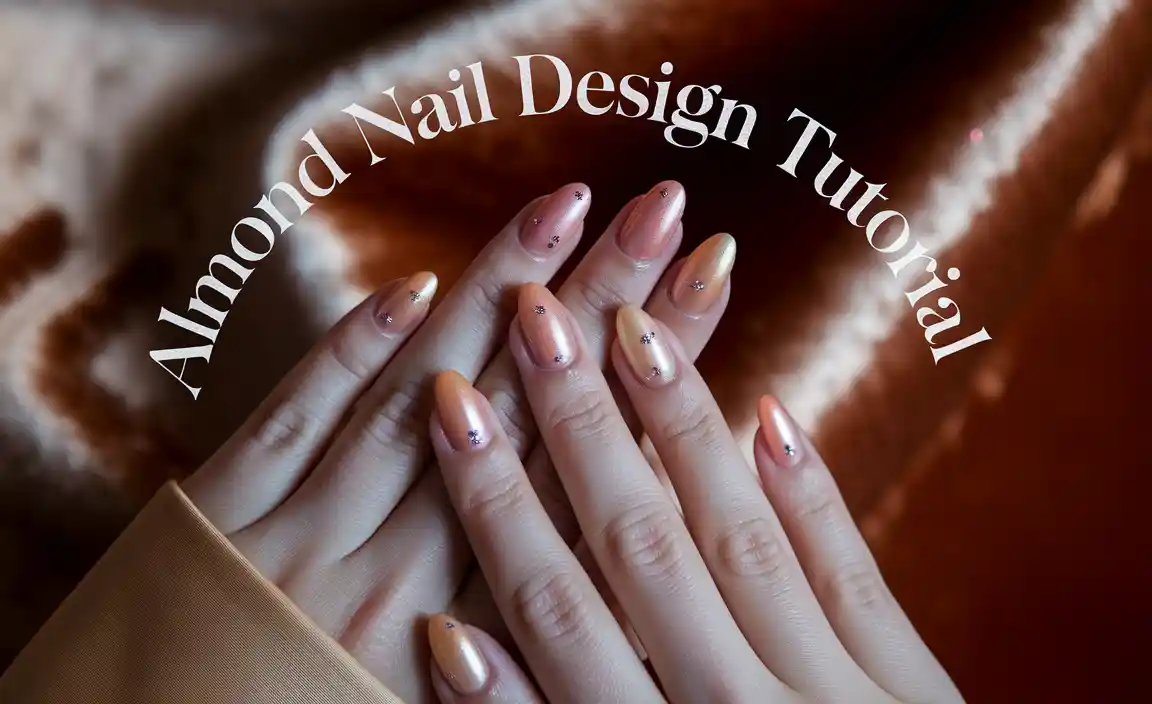Transform your nails into elegant almond shapes with this easy-to-follow tutorial filled with essential tips. Learn the best techniques for filing, shaping, and decorating your almond nails for a chic, sophisticated look. Get ready to elevate your at-home manicure game!
Hello, lovely nail enthusiasts! Ever look at those perfectly tapered almond-shaped nails and wish you could achieve that chic look without a salon visit? You’re not alone! The almond shape is super popular for a reason – it’s incredibly flattering and elegant, elongating your fingers beautifully.
But getting that perfect point without breaking your nails or ending up with a lopsided mess can feel a bit daunting, especially when you’re just starting. Don’t worry, I’m here to guide you through every step. With a few key tips and a little practice, you’ll be rocking gorgeous almond nails in no time. Let’s dive in and discover how to create stunning almond nail designs that will make your hands feel like a million bucks!

Why Choose the Almond Nail Shape?
The almond nail shape is a timeless favorite for many, and for good reason! It offers a unique blend of sophistication and versatility that appeals to a wide range of styles. Unlike sharper shapes like stilettos, the almond offers a softer yet still striking silhouette. Its tapered sides and slightly rounded tip provide an elegant aesthetic that can make fingers appear longer and slimmer.

This shape is also incredibly forgiving. While it has a distinct point, the rounded tip means it’s less likely to snag or break compared to extremely sharp nails. This makes it a practical choice for those who want a stylish look without sacrificing everyday functionality. Whether you prefer minimalist polish or intricate nail art, the almond shape serves as a beautiful canvas, enhancing whatever design you choose to adorn it with.
Aesthetic Appeal
- Elongating Effect: The tapered sides visually lengthen the fingers, offering a slimming and graceful appearance.
- Sophisticated Silhouette: It strikes a perfect balance between soft and sharp, exuding elegance.
- Versatile Canvas: Works beautifully with a vast array of nail polish colors and intricate nail art designs.
Practicality and Durability
- Reduced Snagging: The rounded tip is less prone to catching on fabrics or getting damaged compared to sharper shapes.
- Comfortable Wear: More comfortable for daily activities than extremely pointed nails.
- Structural Strength: When filed correctly, it can be quite durable, especially on natural nails or with enhancements.
Gathering Your Essential Tools
Before we start shaping, let’s make sure you have all the goodies you’ll need. Having the right tools makes the whole process smoother and helps you achieve that salon-perfect finish. Think of these as your trusty sidekicks in the quest for beautiful almond nails!
Having the right supplies is key to success. Here’s a list of the must-haves for any almond nail design tutorial:
- Nail File: A good quality file is essential. A medium-grit file (around 180-240 grit) is perfect for shaping natural nails, while a coarser grit might be used for acrylics or gels. A fine-grit file (320+ grit) is great for smoothing.
- Nail Buffer: A buffer block helps smooth out any ridges and gives your nails a nice sheen.
- Cuticle Pusher/Orange Stick: Gently push back your cuticles for a clean nail bed and a better surface to work with.
- Nail Clippers: For trimming any excess length before you start filing.
- Top Coat and Base Coat: Crucial for protecting your nails and making your polish last longer.
- Nail Polish Colors: Choose your favorites!
- Optional: Nail Art Supplies: Think glitter, rhinestones, nail tape, dotting tools, or stamping plates if you’re feeling creative!
- Rubbing Alcohol or Nail Polish Remover: To clean your nails before applying polish.
Having these on hand ensures you’re prepped and ready to create those perfect almond tips. Don’t worry if you don’t have everything right away; many of these are standard in any nail kit.
Step-by-Step Almond Nail Shaping Tutorial
Ready to sculpt those nails? This section is all about the shaping process. We’ll break it down into simple, manageable steps, perfect for beginners. Remember, patience is your best friend here! Aim for evenness and symmetry.
Step 1: Prep Your Nails
Start with clean, dry nails. Remove any old polish. Gently push back your cuticles using a cuticle pusher or an orange stick. If your nails are too long, trim them down with nail clippers to a manageable length before you begin filing. This makes shaping much easier and prevents breakage.
| Action | Purpose |
|---|---|
| Remove Old Polish | Ensures a clean surface for shaping and polish application. |
| Push Back Cuticles | Creates a larger nail surface and prevents cuticle damage during filing. |
| Trim Excess Length | Makes filing more efficient and reduces the risk of splitting. |
Step 2: Outline Your Shape
Visualize where you want the taper to be. Imagine a gentle slope from the sides of your nail towards the center tip. You can even lightly mark this with a fine-grit file or a pencil if it helps guide you. You’re aiming for a soft point, not a sharp dagger!
Step 3: File the Sides
Using your medium-grit nail file, begin filing one side of your nail at an angle. Start from the side wall of your nail and angle the file inwards towards where you want the tip of your almond to be. File in one direction to create a smooth edge. Repeat on the other side, trying to match the angle. This is where the ‘almond’ shape starts to form.
Step 4: Shape the Tip
Once both sides are tapered, focus on the free edge (the tip of your nail). Use your file to gently shape this into a soft point. Again, file in one smooth motion. Think of it like drawing a gentle ‘V’ or a rounded triangle. Keep checking your progress in a mirror to ensure both sides are symmetrical.
Step 5: Refine and Smooth
Now, use your file to refine the shape and smooth out any rough edges. Gently file the very tip to round it off slightly, ensuring it’s not too sharp. You can also use a fine-grit file or a buffer to smooth the entire surface of your nail, removing any ridges and preparing it for polish. A well-smoothed nail is key to preventing snags and creating a flawless base.
Step 6: Buff for Shine
Use the buffer block to buff the surface of your nails. This will smooth out any remaining imperfections and give your nails a healthy sheen, even before applying polish. A smooth surface is vital for long-lasting polish.
Step 7: Clean and Polish
Wipe your nails with rubbing alcohol or a nail polish remover to remove any dust or oils. Apply a base coat, followed by your chosen nail polish color(s), and finish with a top coat for shine and durability. Allow each layer to dry completely between applications.
Pro Tip: If you’re working with acrylics or gel extensions, the filing process might be slightly different, and you might use a coarser grit file or an e-file. Always consult with a nail technician or professional if you’re unsure about working with enhancements.
Almond Nail Design Ideas for Every Style
The almond shape is a fantastic base for a wide range of designs! Whether you love subtle elegance or bold statements, there’s an almond nail design for you. Let’s explore some popular options that really shine on this shape.
1. Classic French Manicure
A timeless choice! The almond shape beautifully accentuates the curved tip of a French manicure. Keep the white tip crisp and clean, or opt for a “French fade” (baby boomer) for a softer look. This design is sophisticated and perfect for any occasion.
2. Solid Color Elegance
Sometimes, less is definitively more. A single, chic color on almond nails is effortlessly stunning. Consider deep jewel tones like emerald green or sapphire blue for a luxurious feel, or go for classic shades like nude, burgundy, or a sophisticated grey. The tapered shape really highlights the richness of solid colors.
3. Glitter and Glam
Almond nails are perfect for a touch of sparkle! You can opt for a full glitter gradient (where glitter goes from heavy at the tip to sparse at the cuticle), accent glitter nails, or even subtle glitter details. Rose gold, silver, or iridescent glitters work particularly well.
4. Ombre/Gradient Effects
The smooth curve of the almond shape is ideal for showcasing the seamless blend of colors in an ombre manicure. Whether it’s a soft nude-to-pink transition, a vibrant sunset blend, or a chic monochrome gradient, ombre designs look absolutely divine on almond nails.
5. Minimalist Lines and Dots
For a modern, understated look, try minimalist designs. Thin black or gold lines painted diagonally across the nail, or a few strategically placed dots near the cuticle, can add an artistic touch without being overpowering. The clean lines of the almond shape complement these subtle artistic touches.
6. Floral Accents
Delicate floral patterns, whether painted or applied as decals, look enchanting on almond nails. Consider small floral clusters near the cuticle or a single bloom on one accent nail. This adds a touch of femininity and charm.
7. Seasonal Themes
Embrace the seasons with your almond nail designs! Think warm, cozy tones and leaf motifs for autumn, icy blues and snowflakes for winter, pastels and floral prints for spring, and bright, tropical colors for summer. The almond shape allows for detailed seasonal artwork.
Tip: When applying designs, consider how the pattern will flow with the natural taper of the almond shape. Patterns that follow the curve or accentuate the point can be particularly striking.
Tips for Maintaining Your Almond Nails
Keeping your almond nails looking fabulous involves a little ongoing care. Once you’ve achieved the perfect shape, a few simple habits will prolong their beauty and strength.
- Moisturize Regularly: Keep your cuticles and the skin around your nails hydrated with cuticle oil or hand cream. Dryness can lead to hangnails and compromise the nail’s integrity.
- Wear Gloves: Protect your nails from harsh chemicals and excessive water exposure by wearing gloves when doing chores like washing dishes or cleaning.
- Gentle Filing: If you need to touch up the shape, always file in one direction and use a fine-grit file. Filing too aggressively or in a sawing motion can weaken the nail tip.
- Avoid Using Nails as Tools: Resist the urge to use your nails to pry, scrape, or open things. This is a sure way to chip or break them, especially the tapered tip.
- Regular Buffing: Occasionally buffing your nails can help maintain their smoothness and shine, especially if you wear them polish-free for a while.
- Check for Chips: Address any small chips or snags promptly. A tiny chip can quickly worsen if not repaired.
Maintaining the shape also means being mindful of how you use your hands. With a little care, your beautiful almond nails will stay looking graceful for longer.
Common Almond Nail Shaping Mistakes and How to Avoid Them
Even with the best intentions, beginners can sometimes run into a few snags when shaping almond nails. Let’s address the most common ones and how you can steer clear of them.
Mistake 1: Filing Too Much Too Soon
Problem: Getting impatient and filing away too much length or shaping too aggressively at the start. This can lead to unevenness or accidentally making your nails too short.
Solution: Always start with a little more length than you think you need and file incrementally. Keep your file moving in one direction. It’s easier to take more off than to add it back! If you’re unsure, use a pencil to lightly mark your desired shape first.
Mistake 2: Uneven Sides
Problem: One side of the nail is filed more steeply than the other, resulting in an asymmetrical shape.
Solution: Constantly compare both sides of the nail as you file. Use your mirror to check the angles. Imagine a central line down your nail and try to create mirror images on both sides. Take breaks to look at your hand from different angles.
Mistake 3: Pointed Too Sharply
Problem: Creating a very sharp, needle-like tip instead of the gentle, rounded point characteristic of an almond shape. This makes the nail more prone to breaking and snagging.
Solution: Focus on a “soft point.” After filing the sides into a taper, use the very tip of your file to gently round off the apex (the sharpest point). Think of a soft triangle rather than a sharp V.
Mistake 4: Sawing Motion Filing
Problem: Using a back-and-forth “sawing” motion with the nail file. This weakens the nail and can cause peeling or splitting, especially at the tip.
Solution: Always file in one direction, from the side of the nail towards the tip. This creates a smoother, stronger edge.
Mistake 5: Forgetting to Smooth the Surface
Problem: Leaving ridges or rough patches on the nail surface after filing, which can affect polish application and longevity.
Solution: After initial shaping, use a fine-grit file or a buffer to gently smooth the entire nail surface. This ensures a perfect base for your polish.
Remember, every nail is different, and it takes practice to master any nail shape. Don’t get discouraged if your first few attempts aren’t perfect. Consistent practice and attention to detail will lead to beautiful almond nails!
Almond vs. Coffin/Ballerina Nail Shape
It’s common to confuse the almond shape with the coffin or ballerina shape, as they both have tapered sides. However, there’s a key difference in how the tip is treated. Understanding this distinction will help you achieve the exact look you desire on your almond nail design tutorial journey.
| Feature | Almond Shape | Coffin/Ballerina Shape |
|---|---|---|
| TAPERED SIDES: | Yes, tapers from the side walls inwards. | Yes, tapers from the side walls inwards. |
| TIP SHAPE: | Softly pointed, with a rounded apex. | Squared off and blunt, like the end of a coffin or a ballerina’s pointe shoe. |
| OVERALL LOOK: | Elegant, graceful, elongating, softer. | Edgy, modern, dramatic, sharp. |
| RISK OF BREAKAGE: | Lower due to the rounded tip. | Higher if not maintained well, or if the corners are too sharp. |
When filing for an almond shape, your primary goal is to create that gentle, rounded peak. For a coffin or ballerina shape, you would file the sides to taper, and then file the very end of the nail straight across, creating a distinct “cut-off” tip. So, if you want that softer, more naturally elegant look, stick to the rounded point of the almond!
FAQ: Your Almond Nail Questions Answered
Have more questions about achieving the perfect almond nail shape? I’ve got you covered!
Q1: Can I achieve almond nails with short nails?
A: Yes! While almond shapes are often more dramatic on longer nails, you can absolutely start shaping them on shorter nails. You’ll just need to allow for some length to develop the taper. Focus on gently filing the sides inwards towards a very subtle point. It might take a little longer to see the full effect, but it’s achievable.
Q2: How often should I reshape my almond nails?
A: This depends on your nail growth rate and how well you maintain them. For most people, a touch-up every 1-2 weeks is sufficient to maintain the shape and remove any imperfections or snags.
Q3: What kind of nail file is best for shaping almond nails?
A: A medium-grit file (around 180-240 grit) is ideal for shaping natural nails. If you have very thin or brittle nails, you might opt for a slightly finer grit. Always finish with a fine-grit file or buffer to smooth the edges.
Q4: How do I prevent my almond nails from breaking at the tip?
A

